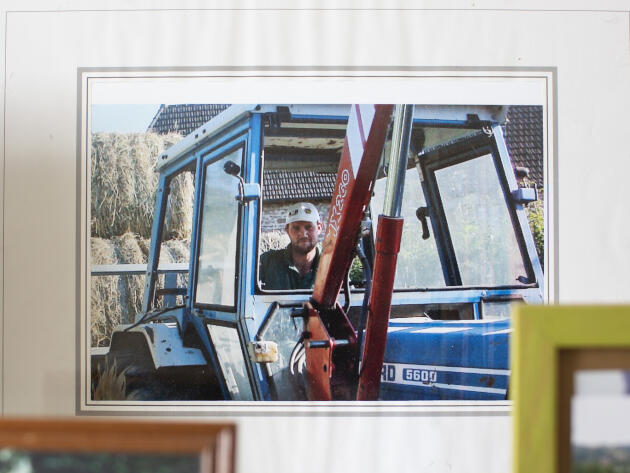Story“The Laronze affair: destiny of a peasant” (1/6). Florence Aubenas, senior reporter at “Monde”, traces the life of a young organic farmer from Saône-et-Loire killed during an intervention by the gendarmerie in May 2017, following various checks on his farm. A drama that has deeply marked this corner of Burgundy.
Who is this guy? Where does it come from? The other day, he caused a sensation in a cinema in Mâcon, in Saône-et-Loire, during a public debate on cattle breeding, a specialty of the region. He’s a tall blond, in his thirties, who seemed to fill the room all by himself with his words, his build, his charisma. In his way of denouncing industrial agriculture, one might have heard an activist from the Confédération paysanne. However, no one has ever seen him at the union, any more than in the small local alternative medium, which organized the debate that day, a few hundred citizens who meet at the Attac committee, in the pot for a peasant-baker or to the actions of Alternatiba, “movement for the climate and social justice”. He presents himself as an organic breeder, 130 animals near Cluny. We are in May 2014. Immediately, the Confederation entrusts a mission to Agnès Vaillant, permanent for the department: to find the tall blond. His name is Jérôme Laronze, he lives in Trivy, 270 inhabitants and four times as many cows.

In the village, we say “up there” to designate Les Senauds, the Laronze farm. Redeemed from small nobles in 1864, it stands on the back of a hill, a strong house, bravely flanked by a dovecote, which embraces the horizon. In front of it stretch the pastures inherited from Jerome’s father, Jean; there, those of the mother, Marie-Jo, brought in her dowry. Hedges of hawthorn and hazelnut trees cut a green checkerboard in the hilly meadows, sometimes with a sudden gap to bypass a pond or a large oak tree. And everywhere, they are there, divided into small herds, the “white”, Charolais cows, a breed known for its marbled meat. Here begins their kingdom, the Arconce valley, barely a hundred kilometers with woods, castles and churches. At the village, we had been disappointed when a boy was born to the Laronze, finally, after four daughters. The farm would therefore not be sold, the son would take it over, necessarily, a breeder even before knowing it, the childhood ordered by the animals, the superb and overwhelming inheritance, for the fifth generation. The sisters had often told him that nothing obliged him to do so. He wanted to, he said.
The breeders still go to the Saint-Christophe-en-Brionnais market “to tell themselves that[ils] born [sont] not quite become the stooges of the industrialists ”
“I have been waiting for you for a long time”, assures Jérôme Laronze by opening the door to Agnès Vaillant, the envoy of the Peasant Confederation, this month of May 2014. He is sincere, she sees it. However, it does not jostle in the Charolais to join this union, minority, labeled “green”. The Confederation has barely 70 members here, especially neorurals, market gardening, goat or beekeeping. Agnès Vaillant knows how traditional cattle breeding is a world apart, difficult to penetrate. Before joining the union, she was one of the first women to run a farm in the region, thirty years earlier. “Where’s the boss?” “, the representatives shouted at her, staring at her. At a meeting, someone had thrown at him: “You are nothing. “ However, what had she liked about her farm and her “white”, these big, gentle animals, a fragile species that makes it necessary to get up at night for births. Sometimes the calf is so weak that it must be carried to suckle.
You have 66.98% of this article left to read. The rest is for subscribers only.
https://wefunder.com/downloadalbumcraigdavidfollowingmyintuitiondeluxe
https://wefunder.com/downloadrhapsodyoffirethefrozentearsofangels
https://wefunder.com/downloadalbumaliceinchainsthedevilputdinosaurshere
https://wefunder.com/tommisch5daymischonepalbumdownload
https://wefunder.com/grupobryndislahistoriagrupobryndisdownload
https://wefunder.com/downloadarchenemykhaoslegions
https://wefunder.com/adamlambertforyourentertainmentalbumdownload
https://wefunder.com/ayrastarrayrastarrepalbumdownload
https://wefunder.com/cityofthesununtitledepdownload
https://wefunder.com/downloaddizzymizzlizzyrotatorremastered
https://wefunder.com/worldclasswreckincrugoldalbumdownload
https://wefunder.com/elinjuchithebookofelialbumdownload
https://wefunder.com/downloadalbumalexistaylorbeautifulthing
https://wefunder.com/blacksabbathheavenandhelldownload
https://wefunder.com/milaj213epdownload
https://wefunder.com/takesurezamarncubeworshipaddictsvendavol1albumdownload
https://wefunder.com/downloadalbumthephantomstaketheworldvol2ep
https://wefunder.com/dieschlumpfediehitsderschlumpfedownload
https://wefunder.com/downloadalbumshawnjamesthedarkthelight
https://wefunder.com/ghanaianstallionfuturesoulalbumdownload
https://wefunder.com/passionworthyofyournamelivealbumdownload
https://wefunder.com/dreamdropyouresleepingalonetonightepdownload
https://wefunder.com/downloadalbummastaacesonofyvonneremixes
https://wefunder.com/downloadalbumpinkfloydtheearlyyears1969dramatisation
https://wefunder.com/ivylabfortunaepalbumdownload